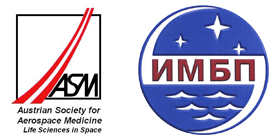A human’s circulation functions only under a balanced co-operation of physical, chemical and biological factors like blood volume, heart and vessel properties, the nervous system and hormone effects. Practically all of these factors change in a state of weightlessness. The resulting changes are similar to longer bed-ridden situations due to, for example, after operations, unconsciousness or various neurological illnesses. Space-flight physiological examinations therefore serve as a model for the solution of clinical problems, irrespective of findings, as a basis for a better understanding of our organism and its functions.
An erect posture is a challenge for the stabilization of blood pressure: Gravity leads to a redistribution of the blood volume in bodily regions below the heart, resulting in a strong reduction of its performance. Standing and sitting therefore also have an important training effect on the circulation, without which the stability of the blood pressure in an erect posture abates (within days) rapidly. Circulation can then be overstrained and a status of “syncope” will arise, meaning that the brain is not supplied efficiently with blood and can lead to unconsciousness and an “orthostatic collapse” – a serious problem for patients as well as astronauts if they are exposed to the earth’s gravity or another celestial body after a sojourn in weightlessness.
With the principle of “lower body negative pressure” (LBNP) it is possible, with the help of negative pressure at the lower half of the body, to relocate blood from the heart in a similar way like during an erect posture under the influence of gravity. Therefore circulation training can also be achieved in weightlessness, and this method is really applied before re-entry to earth (or before a Mars landing in the future). In the experiment “Bodyfluids” this instrument was additionally used for the basic physiological research and the study of fluid discharge in the vessel, similar to what happens when standing.
Objectives
The goal of the experiment “BODYFLUIDS-INTERSTITIUM” went in multiple directions:
Study of hormonal regulation mechanisms, the loss in blood volume through the influence of stimuli effecting the circulation, and the composition of fluids affect the finest exchange vessels (capillaries and small venules) on one hand, and the intersitium back to the blood on the other hand (lymph fluid). The build-up of lymph fluid also plays a decisive role in connection with the development of edemata and vessel dehydration. (The lymph vessels are a special drainage system whose task is to compensate for the slight loss of filtrate and protein in the vessel through the return transport to the blood).
In the experiment, blood samples were taken in order to indirectly study the mentioned phenomena through the changes in the blood composition. Changes in the hormone concentrations in the cosmonaut’s blood plasma indicate the way how the body’s physiological regulation systems answer to circulation strain – and therefore also give a picture of a human’s circulation fitness in weightlessness.
Functionality, Measuring principle
Precise and reproducible stimuli are required for an exact circulation test. Hence the Russian negative pressure pants “TSCHIBIS” was used for the experiment. This created suction at the legs, where blood relocated from upper to lower body regions and therefore provoked a similar circulation state (low filling of the heart) like when standing under the influence of gravity. In the “BODYFLUIDS-INTERSTITIUM” experiment – known as LBNP (lower body negative pressure) – this measure was used as a definite stimulus for pressure on the circulation. An Austrian characteristic was the measuring device “PROTEINOMETER” which determined the speed of sound in blood and plasma samples. The speed of sound (like mass density) is proportional to protein concentration and therewith also a part of red blood cells in volume of the whole blood sample (“hematokrit”). Due to the extremely small changes resulting from the experiment, the use of a particularly precise measuring method was required.
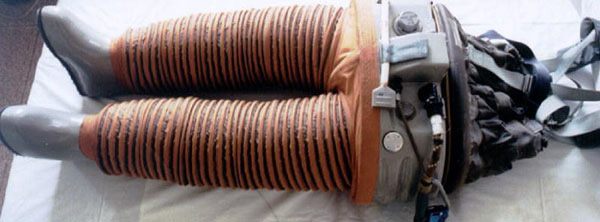
Each LBNP try was carried out with the use of the negative pressure pants “TSCHIBIS” with the following log: 15 minutes at -15 mm Hg, 15 minutes –30 mm Hg and 10 minutes –35 mm Hg.
The blood-taking took place at the following times: 10 minutes before the start of LBNP, 3 minutes after the start of LBNP, as well as 2 minutes after completion of LBNP (minute 42). A total of 20 ml of blood was taken in two 10 ml syringes, whereby one contained heparin and the other EDTA for the anti-coagulation of the blood samples.
The reconditioning of the blood samples resulted in a win of 2 ml plasma samples that were subsequently stored at -25°C. Additionally, 2 ml of blood in a heparinized syringe was removed, both for the determination of the speed of sound with the help of the proteinometer, and for the measurement of hematokrit. Subsequently the blood plasma samples won from the centrifugation were also measured with the PROTEINOMETER.
The treatment of the blood samples was done with the device complex “PLASMA-02”. It included the following components:
- A special centrifuge that sequentially enables the separation of blood cells and plasma, and then the separation of air and plasma;
- A refrigerator that enables the freezing and storing of the samples at -25°C;
- A thermo-isolated cool-tank for the transport of the deep-frozen samples on earth.
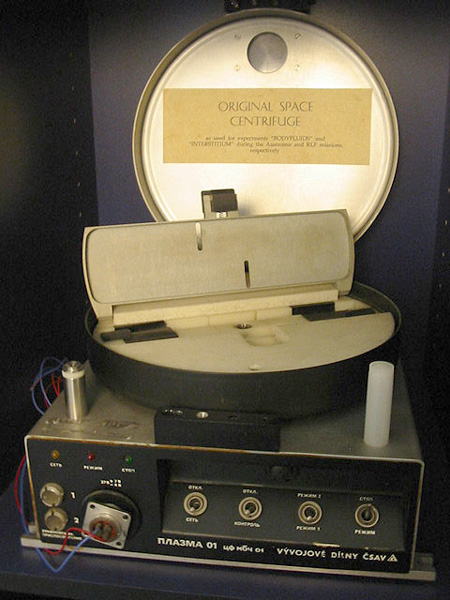
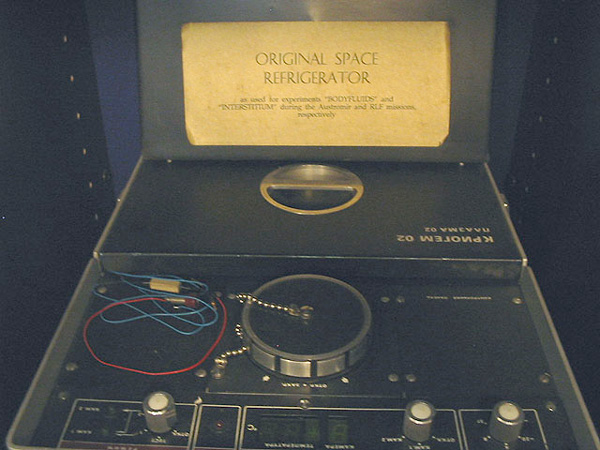
All the components required for the taking of blood where contained in the blood-taking set “VENE”. The determination of the micro-hematokrit was done with the centrifuge “KOMPUR-1100”.
The cosmonaut himself took the blood samples with the blood sampling set “VENE”. This was measured directly and blood plasma was extracted and finally brought back to earth in a frozen state. It was transported and examined in Austria with the cooperation of AUA.
Shared equipments of the Austrian payload
MONIMIR
Results
The results of the speed of sound measurements were hard to interpret because the “PROTEINOMETER” device was originally thought of being used only once (requirements of the “AUSTROMIR-91” project management). The device on board the MIR space station was then reactivated for RLF on request of the Russian side. If a continuation of the experiment was planned beforehand, one would have either planned for a cleaning of the device after being used with blood and plasma samples or basically another measuring principle (mass density measurements based on the bending oscillator principle – comp. Hinghofer-Szalkay, J Appl Physiol 1986; 60: 1082-8) – how it was originally planned for AUSTROMIR-91. The bending oscillator is considerably easier to clean than the specially constructed PROTEINOMETER with metal chambers and a double-cylinder filling system. A cleaning kit brought later to the space station could not clean impurities from the previously successful AUSTROMIR measurements sufficiently to enable reliable measurements.
However the endocrinical measurements – 45 days before the flight, flight days 3, 170, 287 and 430, as well as 4 and 90 days after the landing – were consistently successful. The hormones aldosteron, noradrenalin, adrenalin, ANP99-126 (atrial-natriuretic peptide), ACTH (adrenocorticotropic hormone), cortisol and vasopressin, the mediator agent cGMP (cyclic guanosin-monophosphate) as well as plasmarenin activity (PRA) were acquired. Changes of the “signal activity” of the pituitary gland, heart, kidney, adrenal gland as well as the sympathetic nerve fibres could be determined in this way as the answer to the applied LBNP standard stimulus.
The following describe the answers of the cosmonaut to LBNP and the values found compared with mean values for orientation:
Catecholamine
These hormones increase the activity of various body systems and increase the fighting and defence preparedness. The physiological concentration area for the stress-dependent metabolic hormone adrenalin is 30-85 pg/ml. A strong adrenalin increase up to the same times like noradrenalin (170 and 287 flight day, as well as 4 days after the landing) was observed in the experiment. However, on the 3 and 430 flight day, as well as 90 days after the landing, no aberrance of the physiological standard was noticed. Just like in laboratory experiments, no distinct reaction to LBNP that provokes psychological stress was observed.
The normal range for the „sympathetic substance“ noradrenalin lies at 185 – 275 pg/ml plasma. All values measured by us exceed this level, especially on the 170 and 287 flight day, as well as 4 days after the landing. LBNP always leads to a rash and strong increase of plasma-noradrenalin, but the values measured lie within an additional strong activity increase of the sympathetic nervous system and/or a prolonged removal of noradrenalin from the circulation. The cause of this observed irregularity is unknown.
Stress-depending hormones
For ACTH – the adrenocorticotropic hormone, a brain cue that activates the accumulation of cortisol – exists a distinct circadian rhythm with peak values in the morning and low values in the evenings, whereby the concentration values differentiate themselves with a factor of 15:1. All ACTH values found on the flight were in the physiological area, this means, between 5 and 80 pg/ml. The LBNP reactions were inconsistent and not strongly distinct, cohering with the pulsatile character of hormone distribution. The strongest ACTH reaction was determined 4 days after the landing.
The normal range for the classic stress-hormone cortisol (maximum values in them morning, minimum in the evenings, ratio 5:1) lies between 10-200 ng/ml plasma, with a daily average value of 60 ng/ml. During the experiments that were carried out on the 170, 287 and 430 days of flight, the cortisol concentration lay in the upper area or above. LBNP sunk the cortisol value persistently and this was seen as typical. Measurements of the free cortisol in the serum and saliva could not be carried out. This would have been interesting because the cortisol values are strongly stress-dependent and change quickly.
Hearth Hormones
The heart is in a position to release hormones on overexpansion that will sink the volume strain again. The physiological area of the concentration of the volume-reducing atrial-natriuretic peptide (ANP) moves between 5-80 pg/ml. The ANP concentration sunk consistently during the LBNP experiment: from 171 down to 135 ng/ml in the pre-flight phase, and down to 4.9 ng/ml at the end of the flight. The long-term adaptation correlation of the haemodynamic and hormonal regulation can explain these phenomena (the central venous pressure ebbs immediately with the entrance into weightlessness). After the landing, the ANP value was higher than during the flight. The LBNP experiment provoked different reactions from the side of the ANP during the experiment’s various phases.
After ANP effects on corresponding target cells, cGMP was originally seen as a “second messenger” rather than a redundant parameter accompanying ANP. A fully unexpected phenomenon emerged through the BODYFLUIDS experiment: in comparison with the pre-flight phase results, the concentration reduced considerably already after a few days after the beginning of the flight. All following values, including the 4th post-flight day, were abased up to the limit of the method’s sensibility. This can allude to a reduced activity of the second messenger mechanism and displayed a previously unknown cell-physiological effect of the long-term flight. A reduced protein kinase activity with slowed synthesis actions in the immune cells may be in connection. Further examinations during the long-term flights were not required in order to confirm the findings and to verify the mechanistic explanation possibilities.
Renin-Aldosteron-System
Aldosteron, the vital „salt saving” and volume-effecting hormone, is subjected to circadian rhythms (the highest concentration occurs in the morning, the lowest during the day, by a ratio of 3:1). The physiological area ranges from 20 – 300 pg/ml. The results obtained by us were in this range. Neither regular quiescent value patterns nor unique LBNP reactions were identified.
The plasma-renin-activity (PRA) – a measurement of the enzymatic activation through the kidneys – should be actually determined from blood samples that were won in the laboratory after a defined resting phase, whereby the subject should not be under the effects of medicaments. Under these conditions, the values normally lie in the range between 0.2 – 2.5 ng/ml/h (the PRA values increase by four times after a physical activity). Naturally, such laboratory conditions could not be maintained in space. Nevertheless, all the values observed by us, even the increase due to LBNP, lay in a range that is typical for a healthy subject. Only a strong increase of PRA (from 7.2 to 9.6 ng/ml/h) was noticeable on the 4th day of the post-flight phase. This indicates an increased sensitivity (increased gain) of the circulation regulation through the high general strain of the early post-flight phase.
Vasopressin
The osmo-regulatory effective („water saving hormone“), even directly vessel effective in extreme situations, peptide-hormone vasopressin (anti-diuretic hormone, AVP), normally exhibits a plasma concentration of 1 – 5 ng/ml (in a euhydrated state – the values can be higher in the morning). The values registered by us didn’t always lie within these limits; while the LBNP experiments increased it, especially in the 9 flight month (+240%), similar to a comparable strong irritation, a weak orthostatic strain led to no vasopressin change. The AVP level increased during the flight. It is difficult to explain the observation on the 3rd flight day because the AVP, like aldosteron, PRA and ANP, was found reduced during LBNP effects.
Recapitulating, it can be said that during this longest space flight of man – against all expectations – it did not arrive to a consistent change of the LBNP hormonal response pattern as the standardized circulation strain. This result finally approves that even long missions (like to Mars), at least in this sub-system, do not necessarily lead to a loss of the organism’s regulatory abilities. For further details of the individual response patterns, see Hinghofer-Szalkay and Ma, Aviat Space Environ Med 1999; 70: 1-5.
Technical characteristics
For the experiment BODYFLUIDS the apparatures PROTEINOMETER and the set for taking blood samples VENE were needed.
The equipement PROTEINOMETER
The apparat PROTEINOMETER allowed the determination of the protein content in the whole blood and the plasma through the measurement of the following parameters:
- Sonic run-time through the bio-material probe (0 – 400 µs)
- Temperature of the bio-material probe (10 – 40 °C)
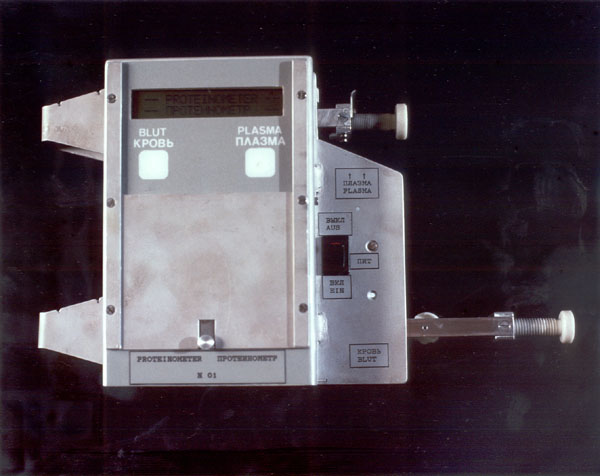
The energy supply of the equipement was carried out autonomous by a set of batteries with a voltage of 9V.
Control elements:
- Master switch
- Start-button for the blood measurement
- Start-button for the Plasma measurement
- Display elements:
- LCD-Display
| Mass: | max. 1.4 kg |
| Dimensions: | 200 mm x 175 mm x 75 mm |
Blood sample taking set VENE
The blood sample taking set included the following expendables for the intravenous blood taking and was packed in a leather sheath:
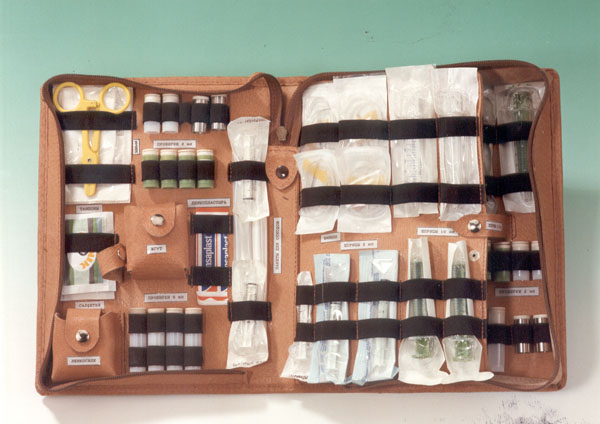
- Shots in different dimensions (22 pieces)
- Eprouvettes in differnt dimensions (24 pieces)
- Butterfly-cannulae (8 pieces)
- Compressions (2 pieces)
- Pads (8 pieces)
- Disinfectant pads (4 pieces)
- Leucoplast (4 pieces)
- Adhesive tape
- Waste bag
- Hose clamps
| Mass: | max. 1.2 kg |
| Dimensions: | 300 mm x 250 mm x 100 mm |
Experimenters
o. Univ.-Prof. Dr. Thomas Kenner (institute manager)
Univ.-Prof. Dr. Helmut Hinghofer-Szalkay (project manager)
all: Physiological Institute of the University Graz
Dr. Viktor Noskov
all: IMBP (Institute for Biomedical Problems), Moscow
Univ.-Prof. Dr. Richard Kvetnansky
all: Slovakian Academy of Science, Institute for experimental endocrinology, Bratislava
